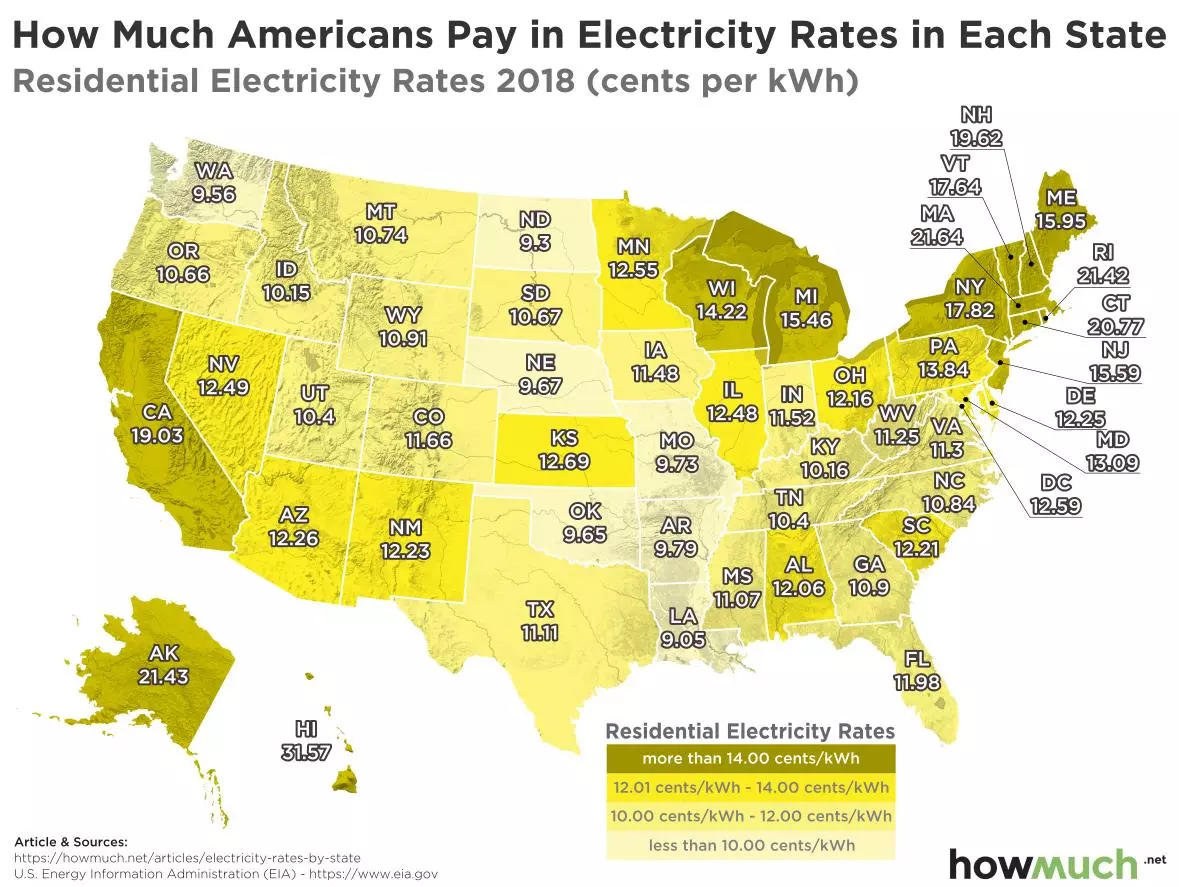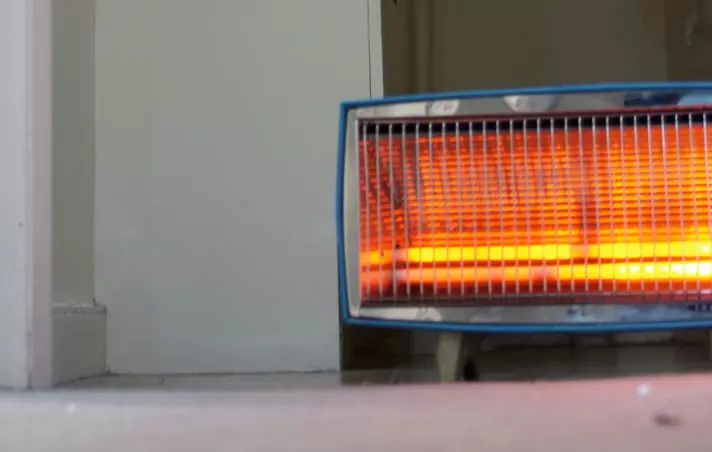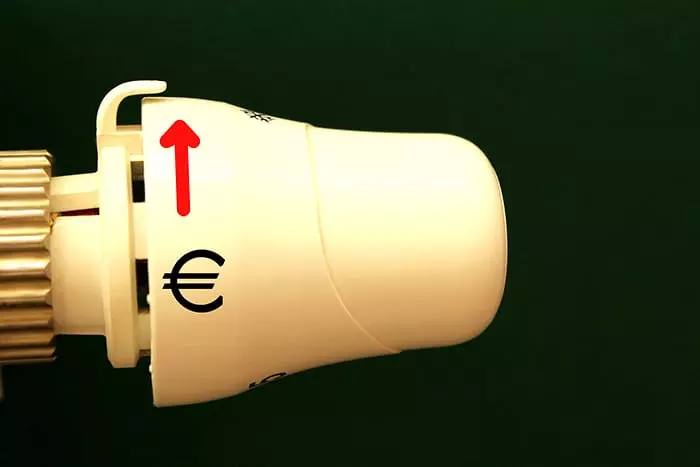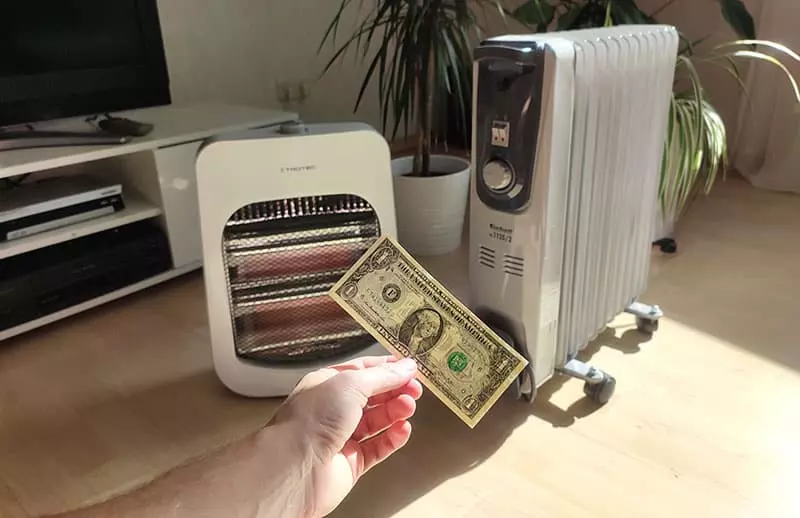How much does a space heater cost to run? Here’s everything you need to know!
In this article, we’re comparing the electricity cost of 21 different space heaters!
I’ll help you decide whether you can afford to run a space heater. And also, I am giving you a simple formula to calculate the exact electricity cost of your space heater model.
Quick answer: A space heater costs $54 per month to run if you use it for 8 hours every day. I assumed an average 1500W space heater and the average US electricity rate of 15 cents per Kilowatt-hour for the calculation. If you run your space heater on lower settings or for shorter durations, the cost to run your space heater decreases accordingly.
To better follow along with this guide, I’ve included as much data on space heater types, power usage, and electricity cost as possible. The data will give you clear information on how a space heater impacts your electricity bill.
To find out how much a space heater will cost to run, we will:
- Check 21 different space heaters of different types and different wattages. I’ve already calculated the costs for them.
- Learn how to calculate custom electricity costs yourself (with a simple and straightforward formula)
- Take a look at the efficiency of space heaters and learn how to run them in a cost-effective way.
So, let’s start!
How much does a space heater cost to run? (I’ve checked 21 different models)
Let’s take a look at 21 examples of space heater electricity costs. In the table below you’ll find some of the most popular space heaters, listed with their type, their power consumption and their cost per month.
But you can also find some niche products like a 4,800W garage heater. So you can find a heater that is similar to the one you plan to get.
To calculate the average costs, I assumed that you run your space heater for 8 hours a day on maximum heat settings. Of course, you’ll save accordingly if you lower the heat.
The space heater electricity costs are based on the average price per kilowatt-hour in the US:
The average residential electricity rate in the U.S. is 14.92 per kilowatt-hour (kWh).
Let’s round that up and set the average electricity rate to 15 cents per kilowatt-hour.
A look at 21 different models and their costs
Here are the results:
| Heater | Type | Power in W | Monthly cost in $ |
|---|---|---|---|
| Lasko 106 | Ceramic | 2000 | 7.2 |
| AmazonBasics Heater | Ceramic | 500 | 18 |
| Bojing Portable Indoor | Ceramic | 900 | 32.4 |
| DOUHE Portable | Ceramic | 900 | 32.4 |
| COMLIFE Heater | Ceramic | 1200 | 43.2 |
| Duraflame 3D | Infrared | 1500 | 54 |
| Lifesmart Easy | Infrared | 1500 | 54 |
| Vornado VH200 | Electric | 1500 | 54 |
| Lasko 754200 | Ceramic | 1500 | 54 |
| Dr Infrared Heater | Infrared | 1500 | 54 |
| De’Longhi TCH8093ER | Ceramic | 1500 | 54 |
| Honeywell HCE200W | Ceramic | 1500 | 54 |
| Lasko AW300 Air Logic | Ceramic | 1500 | 54 |
| Heat Storm HS-1500-PHX-WIFI | Infrared | 1500 | 54 |
| DeLonghi EW7707CM | Oil-Filled | 1500 | 54 |
| Pelonis Heater | Oil-Filled | 1500 | 54 |
| Dyson Pure Hot + Cool | Electric | 1575 | 56.7 |
| Stiebel Eltron CKT 20E | Electric | 2000 | 72 |
| Cadet RCP402S | Electric | 4000 | 144 |
| NewAir NGH500GA00 Garage Heater | Electric | 4800 | 172.8 |
| Dr. Infrared DR-910F | Electric | 10000 | 360 |
As you see, the cost to run a space heater depends only on the power consumption of it. It doesn’t matter whether it’s an infrared or oil-filled heater.
For example, all heaters that operate on 1500W will cost you about 54$ per month. It doesn’t matter which type or brand they are.
And it doesn’t matter whether your space heater is cheap or expensive.
Let’s assume you plan to get a new space heater. To predict the electricity costs of it, basically, all you need to do is to find another heater from the list above that has a similar power rating. All 1500W heaters cost the same.
Important Note: The electricity cost of a space heater doesn’t tell you anything about the space heater’s efficiency. That’s a different story. Keep reading to learn more.
How to calculate space heater electricity cost
The space heater costs above assume that you run your space heater for 8 hours every day. Also, the space heater costs above are based on the average electricity price of about 15 cents per kilowatt-hour in the US.
But what if you want to run your space heater for shorter or longer periods of time? And what if your electricity price is higher? For example, in Massachusetts, the average price is about 24 cents per kilowatt-hour.
Well, then you’ll need to calculate your own custom space heater electricity cost prediction.
3 Steps to find your electricity costs
Here’s how you can do it.
- Find the electricity costs per kilowatt-hour in your home (or your state). You can do that by looking up your last electricity bill. Or you can take a look at the infographic in the next section which shows the average US-household electricity costs by state.
- Then, decide how long you’re going to run your space heater each day. If you want to run your space heater for 8 hours per day in wintertime and 1 hour per day in summertime, you can also estimate the average amount of hours to be in between those two.
- Use this formula to calculate your own space heater electricity cost prediction:
Space heater cost per hour = electricity cost (in dollar per kilowatt-hour) * power (in watt) / 1000
Here’s an example:
Mike wants to get a new infrared heater. But he’s worried about his electricity bill. So, he looks up the electricity costs in his state:
He finds that in Michigan, his electricity rate is 15.46 cents per kilowatt-hour, which is the same as $0.1456 per kWh.
To calculate the cost for his infrared heater of 1500W, he uses the formula:
Cost per hour = $0.1556 * 1500W / 1000 = $0.2319 per hour
Which is about 23.2 cents per hour.
Troubleshooting:
If your result looks a little weird, here’s what could have possibly gone wrong with your calculations
Common mistakes:
- You calculated with the wrong metrics: cents instead of dollars (15 cents per hour instead of $0.15 per hour)
- You forgot to divide by 1000
Average Electricity Rates by State
 Source: howmuch,net
Source: howmuch,net
Using this infographic you can easily look up your electricity rates. If you’re from another country, a quick google search will do the job.
I’ve found it interesting that according to statista.com, in Germany you pay the highest rate of $0.33 per kWh while in Argentina, it would only cost you $0.01 per kWh.
What space heater electricity cost depends on
Let’s take a quick glance at the formula below.
Space heater cost per hour = electricity cost (in dollar per kilowatt-hour) * power (in watt) / 1000
our formula
As you can see it depends on just two parameters. The first one is your personal electricity rates. The second one is the power usage of your space heater in watts.
You can find your electricity costs per kWh by looking at your last electricity bill. And you can easily find the power your space heater needs to run on the packaging or on the space heater itself.
Understanding that costs depend entirely on these two factors is important.
That’s why no matter which 1500W space heater you buy, you always have to pay the same electricity cost.
It’s a myth that space heaters that claim to be eco-friendly really decrease your electricity bill. As long as they consume the same power as other heaters, they will cost the exact same.
To decrease the electricity cost, a space heater has to decrease the power usage and therefore (most likely) also decrease the heat it produces.
Conclusion:
Two space heaters with the same wattage will both cost the very same to operate.
How much power does a space heater consume?
As you can see in the table above, most space heaters consume 1500W of power.
The reason is that 1500W can deliver a good amount of heat while still being safe to run in your home circuit.
Heaters that use less power are even safer to run. However, they don’t heat very well. Similarly, heaters that use more power are less safe to run in your home circuit. But they can produce much more heat.
It seems like 1500W is the optimum amount of power for regular home space heaters.
However, there are also other types of space heaters for special applications. That’s why you can also find small 200W heaters on the list. They are small but can keep your hands warm in an office. And you’ll also find heaters up to 10,000W. They are best to use in industrial applications or in big, uninsulated garages (by the way, here’s a link to a guide on how to heat an uninsulated garage).
Generally, power consumption has nothing to do with the type of heater you use. Each type of heater (infrared, ceramic, oil-filled, …) is available on different power levels.
Power consumption gives you a hint on how much heat your space heater can deliver.
But there’s another metric that’s important:
Efficiency.
Let’s take a look.
Which space heater is the most efficient?
Power is not the only parameter that impacts the heat output. Efficiency is similarly important.
Different types of space heaters are efficient in different use cases.
For example, for quick heating, infrared heaters are most efficient, because they can heat up within a few seconds.
“Typically an infrared heater just 40% the size of a traditional convection radiator will produce the same level of comfort. So a 1kW convection heater will produce the same level of comfort for the occupant as a 400w infrared heating panel.”
However, infrared heaters are not the best choice for heating whole rooms. They are only 40% more efficient than other types of heaters, because they focus the heat in one direction. You can point the focused heat in any direction and heat just that part of your room.
In contrast, oil-filled radiators are the most efficient heaters to keep a whole room warm.
Even though they need more time than infrared heaters to heat up, they can produce lots of warm air once they get going.
Here’s something only a few people understand:
Efficiency depends on your usage
There’s not one type of space heater that’s most efficient. Efficiency depends on what and how you want to heat with the heater.
Here’s a small list on (what I believe) each space heater is best to use for:
- Infrared heaters - for heating yourself or limited space in a room
- Ceramic heaters - for heating small rooms quickly
- Oil-filled heaters - for heating large rooms (rather slowly)
- Propane heaters - for lots of instant heat (also in locations without power supply)

How to use a space heater efficiently to reduce electricity costs
Up until now, we’ve discussed which parameters impact space heater costs. It’s electricity rates, power usage, and efficiency.
If you combine them all to get a bigger picture, you get: Usage.
Electricity costs depend on how you use your space heater. Which power settings do you select? And which space heater do you use for which occasion?
Let’s take a look at an example.
In the list above, I’ve included a few bigger sized garage heaters. For example, the NewAir NGH500GA00 Garage Heater. It uses 4800W (!), which is more than three times the power of a regular heater.
The calculations for space heater electricity costs are all done assuming you run the space heater for 8 hours straight. But nobody will leave a garage heater on for 8 hours a day.
The heater is just too powerful and you probably don’t need all the heat. You also wear thick clothes when you’re in a garage.
If you like to spend time in your garage, you can, for example, heat in short bursts. For example, you run the heater for 10 minutes and then turn it off for an hour. Then you heat, turn off, heat, etc. (over and over again).
Let’s call it heat cycling.
Using heat cycling, you decrease the total hours that your space heater runs. Let’s estimate that over the course of 8 hours, you heater ran for about 1 hour.
This would decrease heating costs from $138.24$ to $17.28 per month.
That does not only apply to garage heaters but all types of heaters:
All the examples in the list assume that you run your heater on maximum power for 8 hours every day - which you mostly don’t need, because you can heat cycle. Still, the results provide a good estimation for your electricity costs
How much does a space heater cost per month?
Short answer:
A space heater will cost about $324 to run per year. However, that doesn’t mean you lose $324 every year. Running a space heater reduces your heating costs. Basically, you save on heating costs (oil, propane, …) and add these expenses to your electricity bill.
How to calculate yearly costs:
Based on what we already know about space heater electricity costs, it gets fairly simple to find out how much a space heater costs per year.
Let’s assume you use the space heater for 8 hours per day in wintertime (6 months).
We already know that running a 1500W heater for 8 hours a day costs you $54 every month.
This means in a year, it will cost:
Yearly electricity costs = 6 months * $54 = $324
Answer: A 1500W space heater will cost an average of around $324 per year. Depending on the state you live in this price varies up and down.
These costs, however, don’t leak out of your pocket. When you use a space heater, you mostly reduce other home heating usage.
“The common methods of heating a home are with an oil furnace, gas heater or hot water boiler. These units require fuel fill-ups on a regular basis and in some cases electricity usage to keep the heater’s motor running.”
That’s what you save on when you use a space heater. You need less fuel to power other heating systems.
It’s like you shift your heating cost from your old heating bill to your electricity bill. You don’t really lose the money.
What’s the best way to save electricity cost
There are dozens of ways to save electricity costs. When researching them I wasn’t really satisfied. The engineer in me awakes.
I found all kinds of tips, ranging from letting the sun shine through your window to dressing properly. However, I’m not really satisfied with them for two reasons.
- They are ineffective.
- You can’t measure your results directly.
In my opinion, from an engineer’s perspective, there are two ways to effectively save electricity costs. Once you do these two things right, your electricity costs will drop.
Why decreasing your thermostat saves you money
The first thing to do is: Decrease the thermostat.
Most space heaters and other heating systems have a built-in thermostat or some other way to control the power.
Here’s why:
“Turn your thermostat down. Reducing it by 1°C could save you energy and money (c.£75 per year)”
The amount of power to heat a room by just one single degree increases really fast. It needs much more energy to increase the temperature from 79 degrees to 80 degrees than increasing it from 69 degrees to 70 degrees needs.
Accordingly, the reverse is also true:
Reducing the temperature by just 1 degree will make a significant impact on your electricity costs. Even though it doesn’t impact your well-being.
Insulate
The second way to reduce your electricity bill long term, even if you’re running space heaters, is to make sure you have proper insulation.
Insulation will reduce the need for heating. Once you heat your room, the warm air will stay warm for longer, because cold air doesn’t leak anymore.
In contrast, if you’re trying to heat a room without a door (which I’ve already written an article on), you’re wasting tons of energy.
You just have to do something in order to keep the heat in your room. You don’t need to add professional insulation. Even adding a simple carpet if you don’t have one, or closing the door will help a lot.
“Insulation will help you keep the desired temperature in your house all year round, protecting it against cold in winter and excess heat in summer.”

Conclusion
An average 1500W space heater costs around $54 per month to run 8 hours a day. This value applies to most households. A day of 24 hours will consist of 8 hours of work, school, or university, 8 hours of sleep, and 8 hours of free time.
We’ve also taken a look at 21 different examples of real, popular space heater models. For each of them, I’ve included the electricity costs together with the type of heater and the amount of power is used. From the results, you can see, that the electricity costs depend mainly on the power usage of your heater.
It doesn’t matter which heater type it is.
Also, local electricity rates impact your space heater costs. You can find your personal rates on your last electric bill and then do the calculations with the formula I gave you.
So, the best way to decrease your costs is to use your space heater efficiently.
For example, using a small, 800W infrared heater is a total waste of energy, because it won’t get you anywhere. Similarly, using a 1500W heater to keep a small storeroom hot is a similar waste of energy.
For each scenario, a different heater is best. For example, infrared heaters are best for heating certain spots in a room. Oil-filled radiators and ceramic heaters are best to heat entire rooms.
So, use your space heater wisely.
By reducing your space heater costs, you don’t only favor yourself, but also the environment.
Saving electricity is one of the few things that harms nobody, but benefits everybody.
